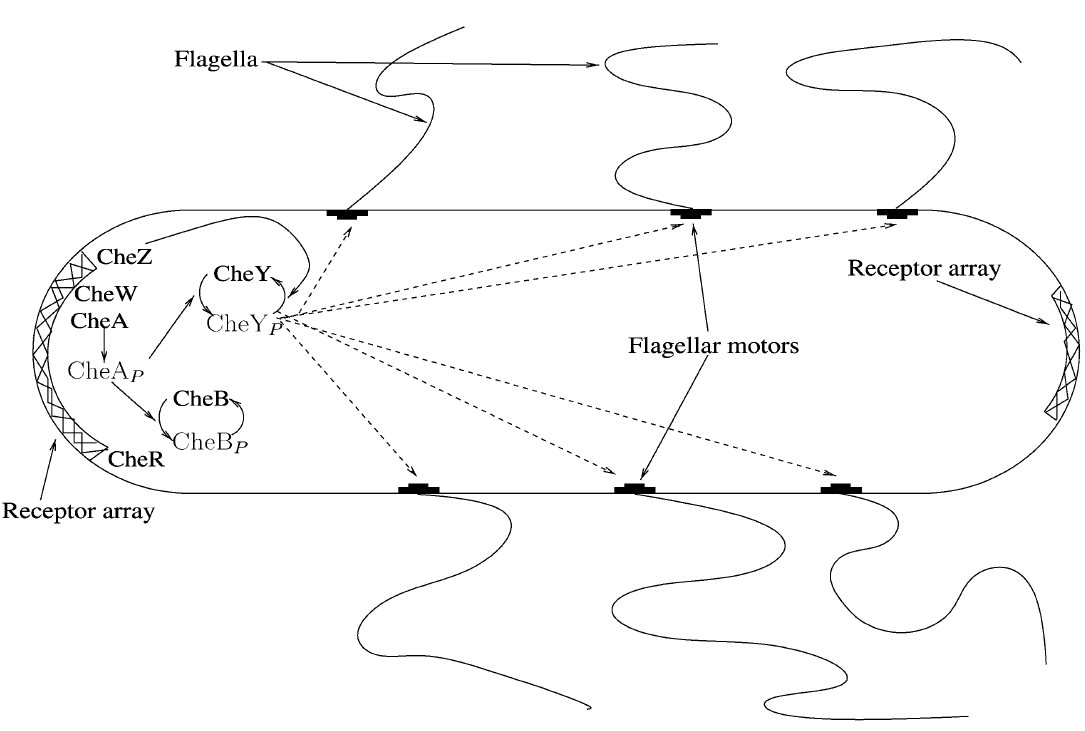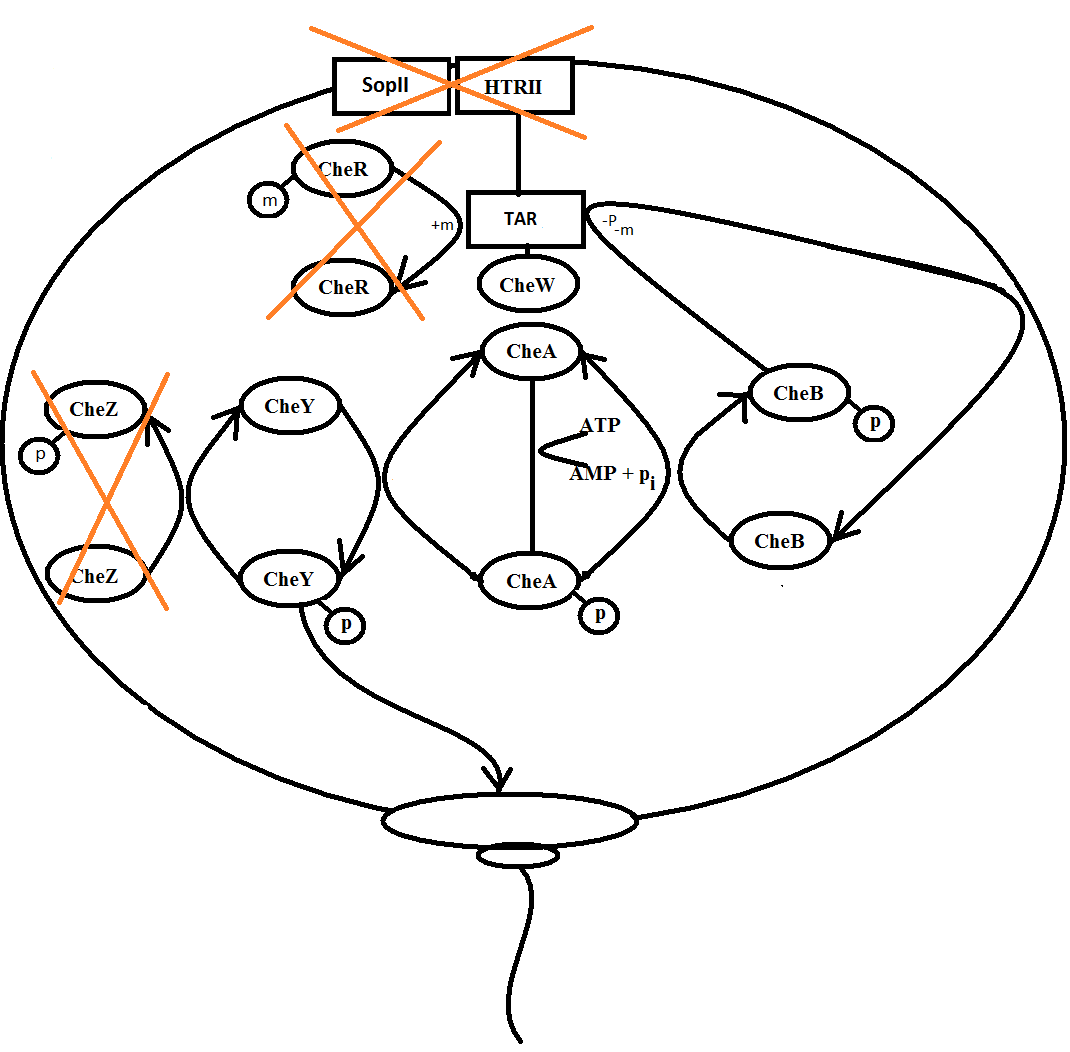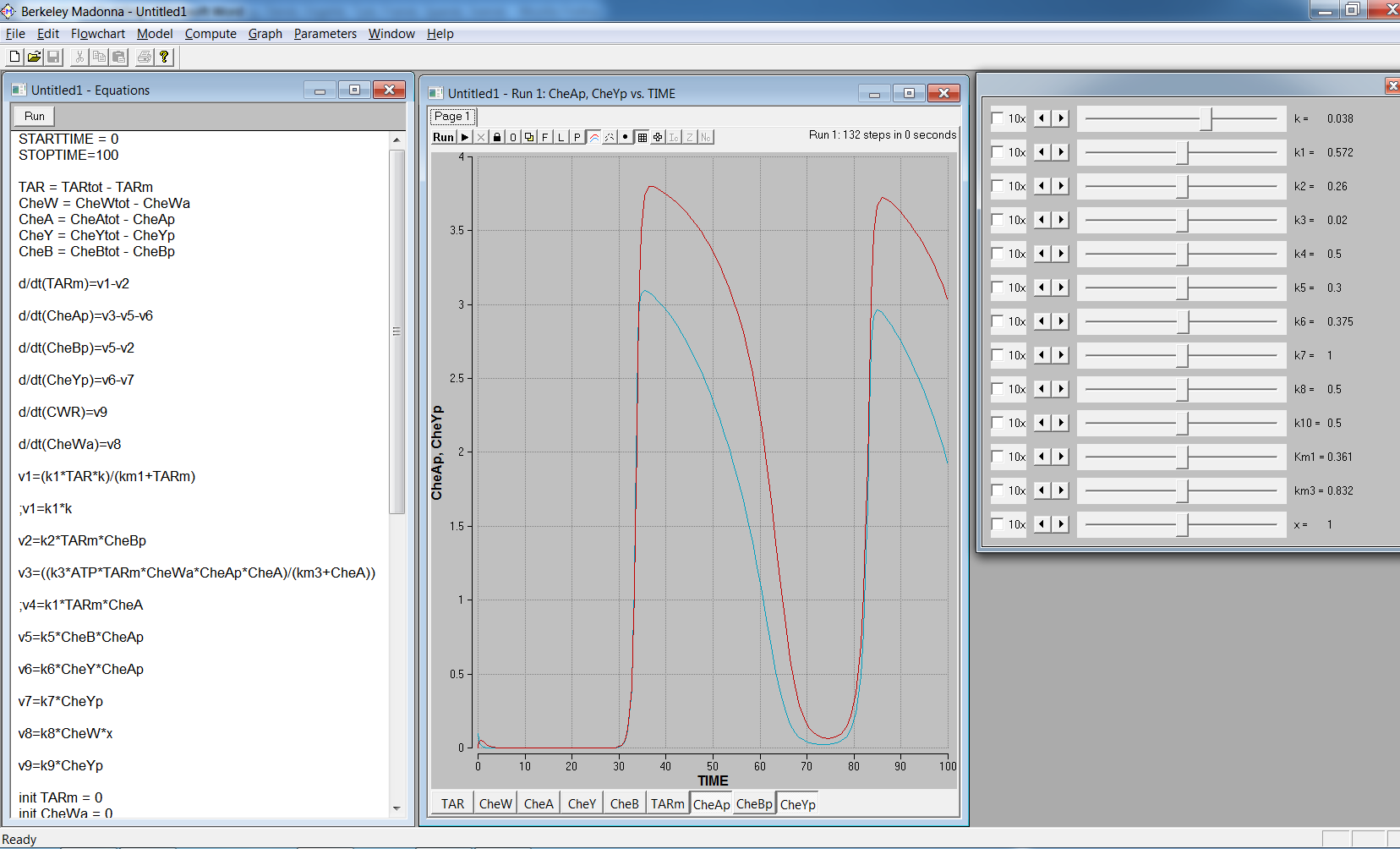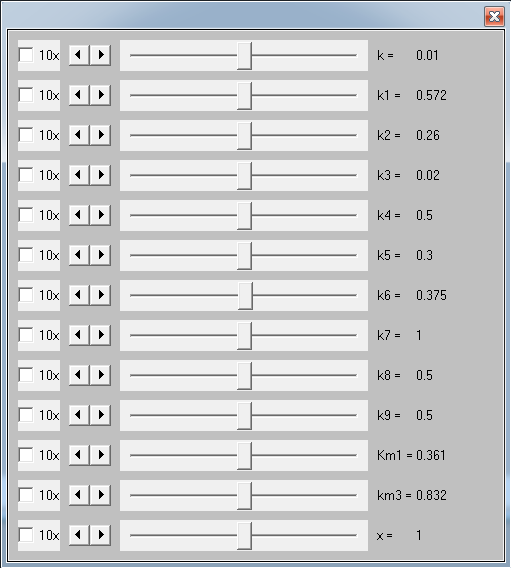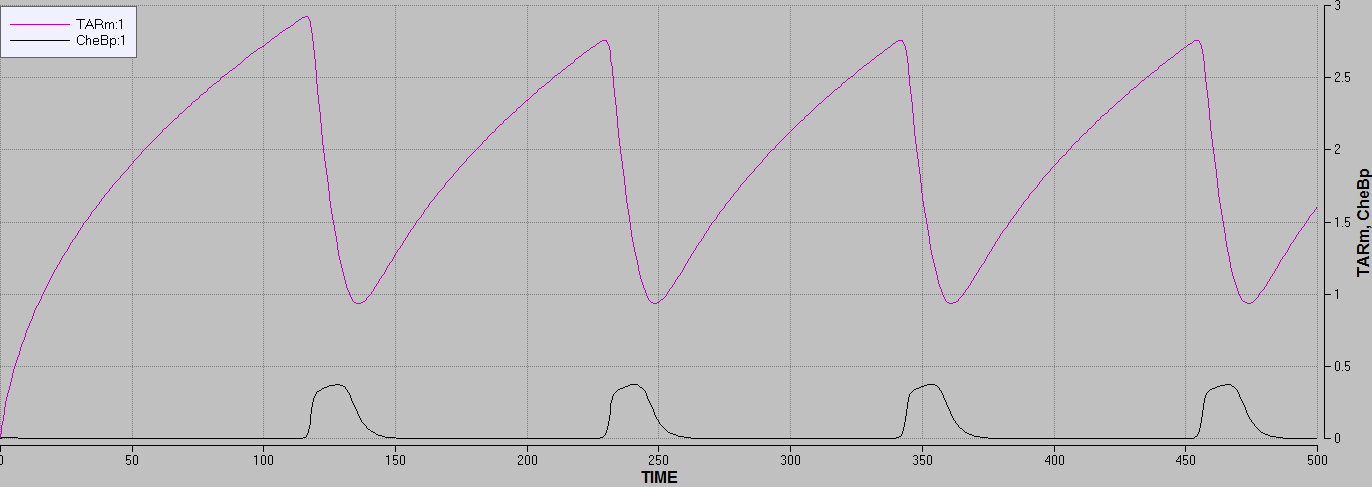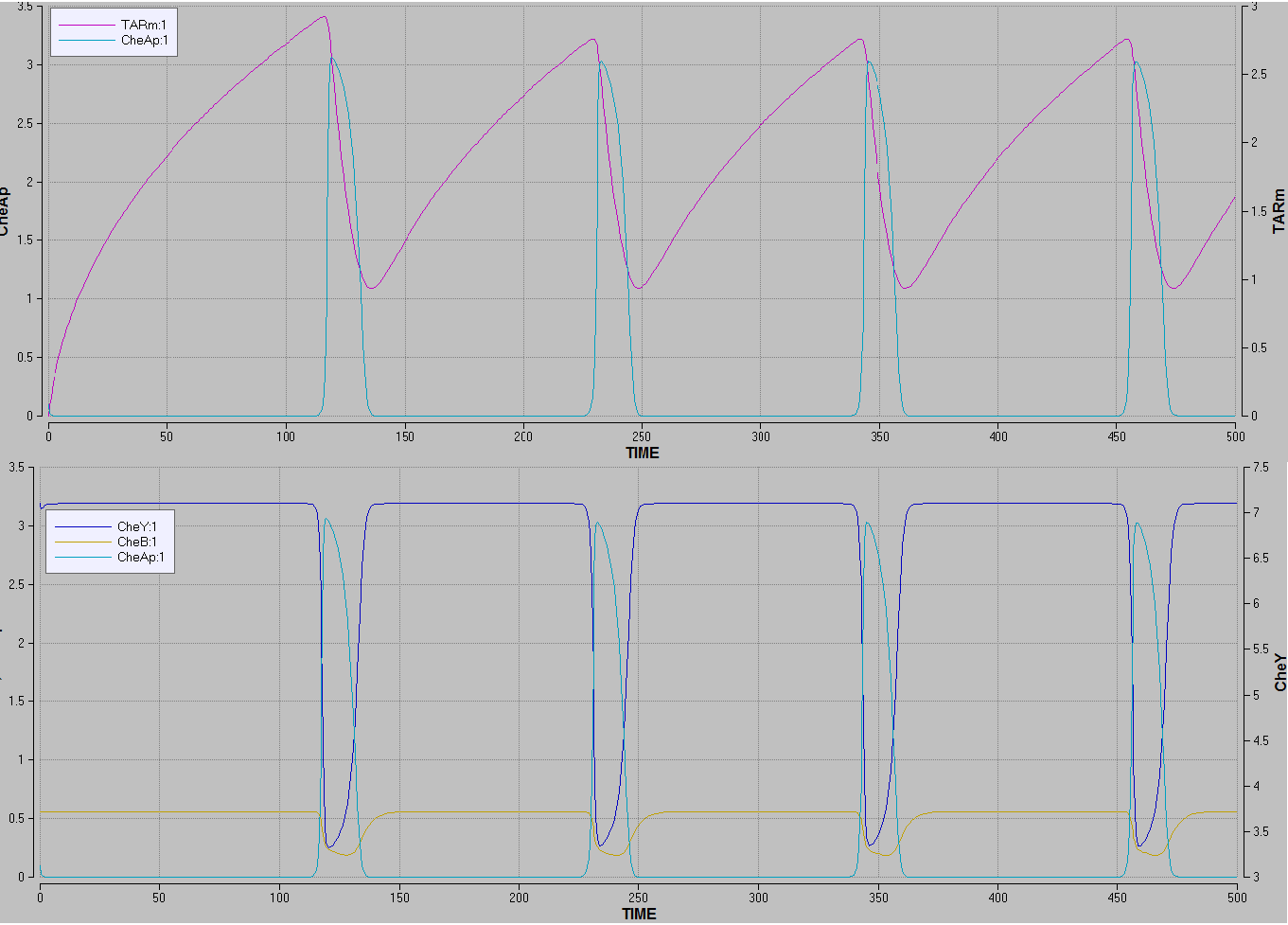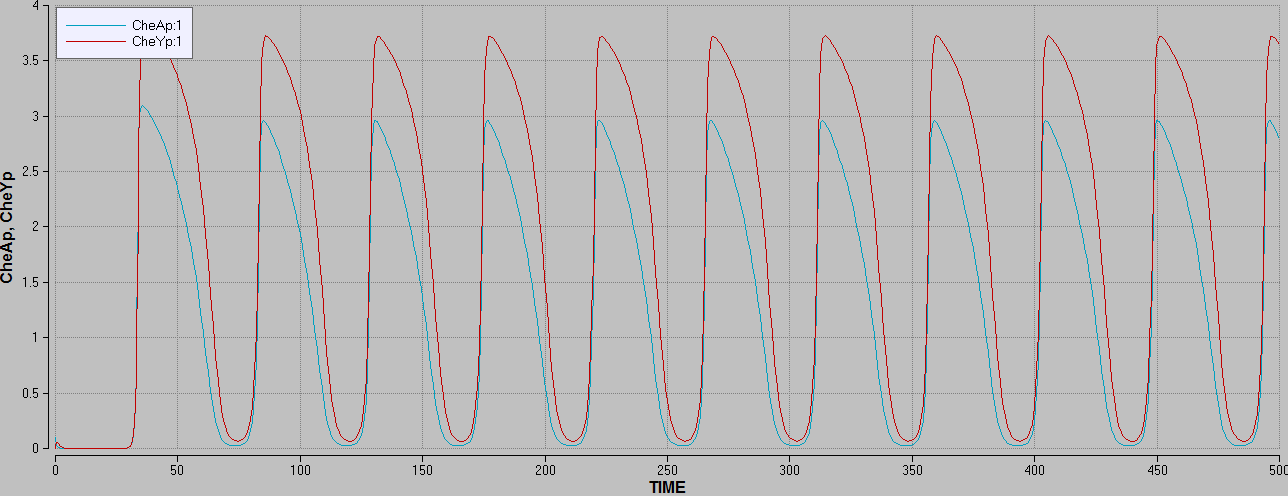Team:SDU-Denmark/project-bc
From 2010.igem.org
(Difference between revisions)
m (→Model results) |
(→Model results) |
||
| (6 intermediate revisions not shown) | |||
| Line 52: | Line 52: | ||
[[Image:Team-SDU-Denmark-TSRm.png|center]] | [[Image:Team-SDU-Denmark-TSRm.png|center]] | ||
<br> | <br> | ||
| - | In Berkeley Madonna it is possible to define different parameters as sliders which enable the user to change parameters continually while the model is running. The sliders used in the model are: | + | In Berkeley Madonna it is possible to define different parameters as sliders which enable the user to change parameters continually while the model is running. The sliders used in the model are:<br> |
| + | [[Image: Team-SDU-Denmark-Sliders.png|thumb|center|550px|'''Figure 4''': Picture from the modelling program Berkeley Madonna, showing the sliders used in the model.]] | ||
<br><br> | <br><br> | ||
| Line 62: | Line 63: | ||
CheY/CheYp<br> | CheY/CheYp<br> | ||
Flagella moters CCW/CW<br> | Flagella moters CCW/CW<br> | ||
| - | The time scale of the model might be to large, because it’s not possible to define units to the different parameters | + | The time scale of the model might be to large, because it’s not possible to define units to the different parameters.<br> |
| + | In the program defining time steps as seconds, minutes and so on, is not possible this problem also involves defining concentrations of the enzymes.<br> | ||
Some of the initial reaction rate constants and enzyme concentrations was from articles, and afterwards optimized for this model [[https://2010.igem.org/Team:SDU-Denmark/project-bc#References 3]].<br> | Some of the initial reaction rate constants and enzyme concentrations was from articles, and afterwards optimized for this model [[https://2010.igem.org/Team:SDU-Denmark/project-bc#References 3]].<br> | ||
| - | + | Focusing on the behaviour of TAR/TARm in the model (Figure 5), it demonstrates that the concentration of methylated TAR rises if no phosphorylated CheB is present in the system.<br> When the concentration of phosphorylated CheB rises the concentration of methylated TAR drops.<br> | |
| - | + | ||
| - | + | ||
| - | Focusing on the behaviour of TAR/TARm in the model (Figure | + | |
This corresponded well with the known theory for the real system. | This corresponded well with the known theory for the real system. | ||
<br> | <br> | ||
| - | [[Image:Team-SDU-Denmark- | + | [[Image: Team-SDU-Denmark-Madonnapic.pngTSRmodel.png |thumb|center|550px|'''Figure 5''': graph showing the concentration of phosphorylated CheB affecting the concentration of methylated TAR, making them drop.]] |
<br> | <br> | ||
| - | Focusing on the CheA/CheAp behaviour in the model (The top graph in figure | + | Focusing on the CheA/CheAp behaviour in the model (The top graph in figure 6), it demonstrates that the CheA auto-phophorylation rate rises when no TAR is methylated, thus producing phosphorylated CheA.<br> |
| - | The dephosphorylation of CheA, is performed by both CheB and CheY (the bottom graph in figure | + | The dephosphorylation of CheA, is performed by both CheB and CheY (the bottom graph in figure 6), rise as the concentrations of both phosphorylated CheB and CheY rise and thereby decreases the concentration of phosphorylated CheA.<br> |
This corresponded well with the known theory for the real system. | This corresponded well with the known theory for the real system. | ||
| - | <br><br> | + | <br> |
| - | Focusing on the CheB/CheBp behaviour in the model which illustrate that concentrations of phosphorylated CheB rises when phosphorylated CheA is present, as seen in figure | + | [[Image:Team-SDU-Denmark-CheAmodel.png |thumb|center|550px|'''Figure 6''': '''The top graph''' is showing the concentration of phosphorylated CheA rising when the concentration of methylated TSR drops. '''The bottom graph''' is showing the concentrations of CheB and CheY rising when the concentration of phosphorylated CheA rises.]] |
| - | This corresponded well with the known theory for the real system. | + | <br> |
| - | + | Focusing on the CheB/CheBp behaviour in the model which illustrate that concentrations of phosphorylated CheB rises when phosphorylated CheA is present, as seen in figure 6 and its dephosphorylation occurs during the demethylation of TAR as seen in figure 5.<br> | |
| - | Focusing on the CheY/CheYp and the flagella motor rotational direction the model illustrates that when concentrations of phosphorylated CheA rises, the concentrations of phosphorylated CheY rises and the flagellar activates clockwise rotation.<br> | + | This corresponded well with the known theory for the real system.<br> |
| + | Focusing on the CheY/CheYp (Figure 6) and the flagella motor rotational direction the model illustrates that when concentrations of phosphorylated CheA rises, the concentrations of phosphorylated CheY rises and the flagellar activates clockwise rotation.<br> | ||
The concentration of phosphylated CheY is proportional to the flagella motor rotational direction, because phosphylated CheY activates Clockwise rotation in the flagellar motors which without phosphylated CheY turns Counter Clockwise.<br> | The concentration of phosphylated CheY is proportional to the flagella motor rotational direction, because phosphylated CheY activates Clockwise rotation in the flagellar motors which without phosphylated CheY turns Counter Clockwise.<br> | ||
The CheY er constantly dephosphorylated by CheZ, which in this case is modelled as the constant k.<br> | The CheY er constantly dephosphorylated by CheZ, which in this case is modelled as the constant k.<br> | ||
This corresponded well with the known theory for the real system. | This corresponded well with the known theory for the real system. | ||
<br> | <br> | ||
| + | [[Image: Team-SDU-Denmark-CheYmodel.png |thumb|center|550px|'''Figure 7''': graph showing the concentration of CheY rising when the concentration of phosphorylated CheA rises.]] | ||
<br> | <br> | ||
| - | This is a simplified model and | + | This is a simplified model and only describes a small part of the real system, this makes the data produced by the model incorrect prediction for actual bacterial behaviour.<br> |
Also the too large time scale is making it impossible too describe what happens when the photosensor in the cell is activated by light. <br> | Also the too large time scale is making it impossible too describe what happens when the photosensor in the cell is activated by light. <br> | ||
| - | When trying too introduce the photosensor and the | + | When trying too introduce the photosensor and the effect of light in the model, the increase in light doesn’t change the system behaviour to a degree that affects the output of the program.<br> |
This might be because the concentration of the enzymes, the rate constants in the model and the other model parameters have been set to high or to low.<br> | This might be because the concentration of the enzymes, the rate constants in the model and the other model parameters have been set to high or to low.<br> | ||
| - | Although several problems exist in the model it is still good enough to model the system behaviour and enzyme interaction on a larger timescale | + | Although several problems exist in the model it is still good enough to model the system behaviour and enzyme interaction but on a larger timescale than seen in nature.<br> |
=== References === | === References === | ||
Latest revision as of 23:16, 27 October 2010
 "
"
